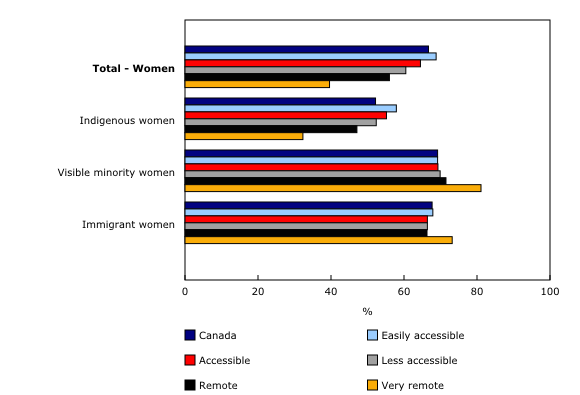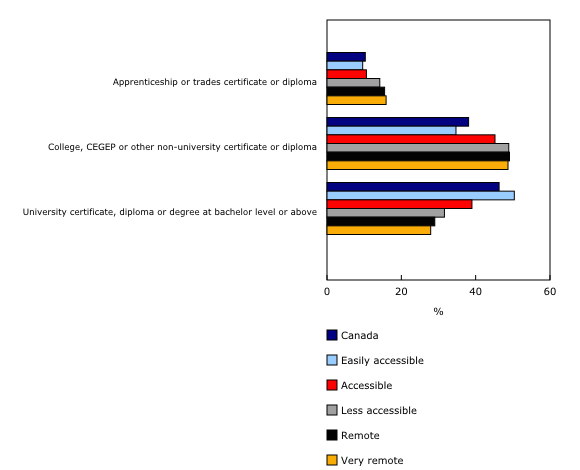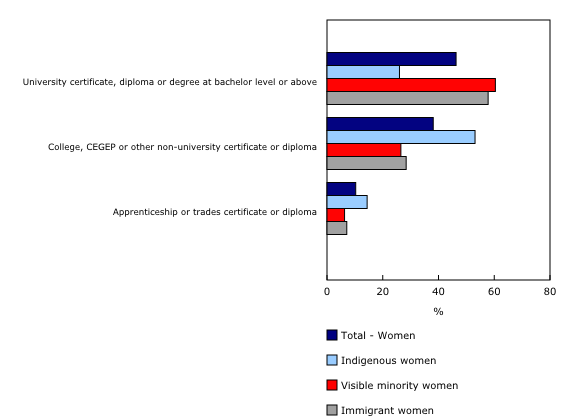Educational attainment of women by the relative remoteness of their communities
Archived Content
Information identified as archived is provided for reference, research or recordkeeping purposes. It is not subject to the Government of Canada Web Standards and has not been altered or updated since it was archived. Please "contact us" to request a format other than those available.
Released: 2022-02-08
Women in Canada are highly educated overall. They are among the most educated in the world and are more likely than men to hold a high school or postsecondary qualification. A majority of women (66.7%) aged 25 to 64 years held a postsecondary qualification in 2016, while 23.3% had a high school diploma as their highest qualification, and 10.0% had no certificate, diploma or degree. However, women's educational attainment varied by the remoteness of the communities where they lived, where the level of remoteness of their communities were determined by their proximity (or distance) to population centres as a proxy for services accessibility, as well as the population size of these communities. A new study released today examines the educational characteristics of women in communities of different degrees of remoteness.
Women's educational attainment is the lowest in very remote areas
The more remote a community was, the lower the postsecondary completion rates of women were. For example, in 2016, more than two-thirds (68.8%) of women had a postsecondary certificate, diploma or degree in easily accessible areas, and this percentage gradually declined to 39.6% in very remote areas.
Immigrant women and women designated as visible minorities have higher educational attainment, especially those living in very remote areas
Women's educational attainment also varied by characteristics, such as Indigenous identity, immigration background and ethnocultural characteristics. For example, 69.2% of women designated as visible minorities had a postsecondary qualification, compared with 67.7% of immigrant women and 52.2% for Indigenous women in Canada. Among the six largest female population groups designated as visible minorities, Filipino women (who represented the largest female population group designated as visible minorities living in more remote communities) had the highest postsecondary completion rate (80.3%).
In contrast to the patterns among women overall, the postsecondary graduation rate of women designated as visible minorities and immigrant women increased as their communities' remoteness index grew. Slightly over four in five (81.1%) women designated as visible minorities living in very remote areas had a postsecondary qualification compared with nearly three-quarters (73.2%) of immigrant women and close to one-third (32.3%) of Indigenous women. The fact that Filipino women had the highest postsecondary completion rate and that they represented the largest female population group designated as visible minorities living in more remote communities may partially explain why the educational attainment of visible minority women increased with the remoteness index. However, given the large underrepresentation of visible minority and immigrant women in more remote areas, it should be noted that this trend does not significantly affect the national average.
A bachelor's degree or higher is the most common postsecondary qualification among women living in easily accessible areas
Postsecondary qualification includes a university certificate, diploma or degree at the bachelor level or above, apprenticeship or trades certificate or diploma, and a college, CEGEP or other non-university certificate or diploma. As the remoteness index increased, the likelihood of women having a bachelor's degree or above decreased. Among women who held a postsecondary qualification, half of them (50.4%) in easily accessible areas held a bachelor's degree or above. This proportion continuously decreased and reached the lowest level in very remote areas, at 27.9%.
Women designated as visible minorities, especially South Asian women, have the highest proportion of bachelor degree (or above) holders of all other groups studied
The type of postsecondary qualification also varied by certain characteristics. Among women who held a postsecondary qualification, women designated as visible minorities (60.4%), especially South Asian women (70.2%), were the most likely to hold a bachelor's degree or above compared with Indigenous women (26.0%), immigrant women (57.8%), or women overall (46.3%), regardless of the remoteness areas categories.
Among the six largest female population groups designated as visible minorities, Black women (38.0%) were less likely to hold a bachelor's degree or above when compared with the national average (46.3%).
Business and health are the most common fields of study among women holding a postsecondary qualification
Business administration and health care were the most common fields of study for women aged 25 to 64 years with a postsecondary qualification, and that held true across all remoteness area categories.
The least common fields of study were legal professions and studies, mathematics and computer and information science, and engineering and engineering technology. As suggested by these results, women aged 25 to 64 years holding a postsecondary qualification were unlikely to have chosen a STEM (science, technology, engineering and mathematics and computer sciences) field of study, especially for those living in more remote communities. For example, 11.6% of women living in easily accessible areas had STEM postsecondary qualification, compared with 5.4% of those living in very remote communities.
Women designated as visible minority and immigrant women are more likely to hold a postsecondary qualification in STEM than any other groups studied
Women designated as visible minorities and immigrant women were more likely to hold a STEM postsecondary qualification than any other groups studied, across all remoteness area categories. For example, among postsecondary qualification holders, 17.0% of women designated as visible minorities and 16.9% of immigrant women held a postsecondary qualification in STEM in 2016 in Canada, compared with 5.8% for Indigenous women, and 10.6% for all women in Canada. Among the six largest female population groups designated as visible minorities, Black women (8.2%) were less likely to hold a postsecondary qualification in STEM compared with the national average (10.6%).
Note to readers
Using data from the 2016 Census of Population and the updated Remoteness Index Classification, this paper is the second of a series of four papers on the socioeconomic and sociodemographic profile of women living in communities at varying levels of remoteness. This report focuses on the educational attainment, type of postsecondary qualification (e.g. apprenticeship or trades, college or CEGEP, or university degree at the bachelor level or higher), and the fields of study of women by the relative remoteness of their communities. The Remoteness Index assigns a relative remoteness value to each census subdivision, based on proximity to census agglomerations as a proxy for service accessibility. This tool groups census subdivisions into five categories of relative remoteness: easily accessible; accessible; less accessible; remote; and very remote.
Products
The report "Portrait of Women by the Relative Remoteness of their Communities, Series 2: Educational Attainment," as part of Studies on Gender and Intersecting Identities (45-20-0002), is now available.
Contact information
For more information, or to enquire about the concepts, methods or data quality of this release, contact us (toll-free 1-800-263-1136; 514-283-8300; infostats@statcan.gc.ca) or Media Relations (statcan.mediahotline-ligneinfomedias.statcan@statcan.gc.ca).
- Date modified:




